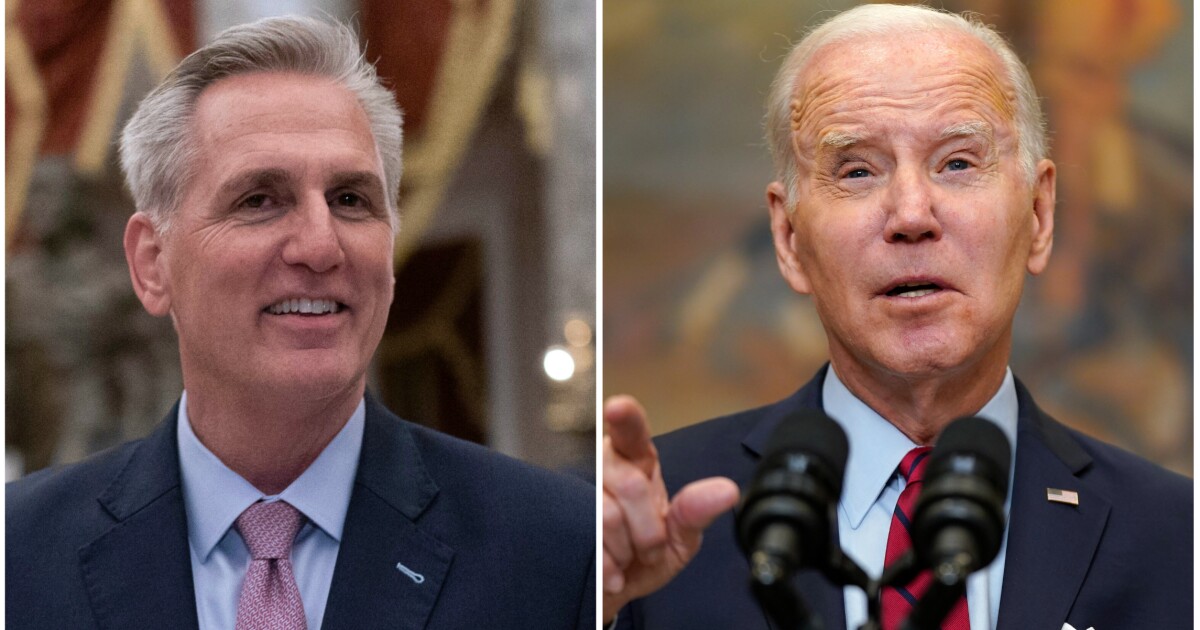

House Speaker Kevin McCarthy (R-CA) fired an opening shot Tuesday in the coming battle between GOP lawmakers and President Joe Biden over raising the debt ceiling.
In a letter to Biden, McCarthy laid out the basics of what House Republicans want in exchange for voting to raise the nation’s borrowing limit.
WHITE HOUSE DENIES MCCARTHY BUDGET NEGOTIATION REQUEST: ‘STOP PLAYING GAMES’
So far, however, the White House appears uninterested in engaging with Republicans.
Here are five takeaways from the GOP proposal.
MILITARY FUNDING ISN’T ON THE CHOPPING BLOCK — FOR NOW
McCarthy wrote in his letter that House Republicans will prioritize “reducing excessive non-defense government spending,” but neither the letter nor public statements from members of House GOP leadership on Tuesday mentioned cuts to defense spending.
Republicans have split in recent months on whether spending reductions should include an effort to trim the military’s budget. Some lawmakers have floated the idea of eliminating bureaucratic layers at the Pentagon or slashing aid to Ukraine.
Others have said Pentagon spending levels should stay untouched given the global challenges posed by China and Russia.
Pentagon funding took up 15.1% of the federal budget in fiscal 2023.
But military support for Ukraine could still emerge as a flashpoint on Capitol Hill in the future — just not, it seems, as part of debt ceiling talks.
House Republicans have started conducting oversight of where aid to Ukraine has gone over the past year, and winding down involvement in the war against Russia has become a rallying cry in the 2024 GOP presidential primary.
COVID-19 COURT BATTLES AHEAD
House Republicans want to pad the government’s bottom line by clawing back unspent pandemic aid, McCarthy said in his letter.
The speaker did not specify which tranche of COVID-19 funding Congress would target or how much lawmakers expect they could recover.
Cities and states received $350 billion in pandemic relief money in 2021 through the Democratic American Rescue Plan; Republicans at the time argued that the sum went far beyond what local governments needed.
More than two years later, cities and states still have not budgeted roughly 32% of that funding, according to the Brookings Institution.
Schools also received pandemic aid well in excess of what they needed to bounce back from COVID-19.
As of last year, school districts had spent just a fraction of their American Rescue Plan money, a $122 billion infusion, and still had not used up all of the funds they received through two previous stimulus bills.
Facing deadlines to offload the money, schools have splurged on everything from teacher bonuses (despite having no staff shortages) to new stadiums.
And while many schools have stepped up the pace of their pandemic aid spending ahead of the money’s September 2024 expiration date, schools would need to spend roughly $5 billion per month until then to use up all the cash, according to the Edunomics Lab at Georgetown University.
Where Republicans want to retrieve pandemic aid remains unclear.
House lawmakers could also run into trouble when determining whether to target unspent pandemic aid that has already been budgeted. Cities, states, and schools could fight in court to hold on to money they have set aside for projects in the future, even though those projects may not exist yet and the money is still sitting in the coffer.
“I’m happy to go claw back COVID money, but I want some of my Republican colleagues who keep talking about that to show me the dollars and show me the path. Don’t get distracted by shiny objects,” Rep. Chip Roy (R-TX) told the Washington Examiner in February. “Yes, there’s probably $90 [billion] to $100 billion in unobligated money. Go get it. Fine. I’m for that. But there’s obligated, unspent money. If you want to go get that back from the states, be my guest, but you’re going to be in court.”
SOME FORM OF ENTITLEMENT REFORM?
Republicans have remained adamant that the most significant entitlement reforms — changes to Social Security, Medicare, or Medicaid — will not be on the table in debt ceiling negotiations.
But a more modest form of entitlement changes will be. McCarthy said Republicans want to impose more work requirements on people receiving government benefits.
“Look, if you talk to anybody in our country right now, everybody is looking for workers. And yet the federal government is paying millions of people about 30 to 40 thousand dollars a year to sit at home,” House Majority Leader Steve Scalise (R-LA) said Tuesday. “It makes absolutely no sense.”
McCarthy specified in his letter to Biden that Republicans are eyeing stricter work requirements for people “without dependents who can work,” although he did not clarify precisely which benefits the plan would target.
Earlier this month, two dozen House Republicans backed a bill that would require people who receive food stamps for a long period of time to find at least part-time work. The bill would also close loopholes that allow 18 states to waive work requirements for food stamps.
House Republicans could also tighten the rules around unemployment insurance or government housing.
TURNING UP THE HEAT ON BIDEN
McCarthy abandoned the hopeful tone he used when discussing the looming showdown with Biden and called the president out for refusing to negotiate.
“We’ve made no progress,” McCarthy said on CNBC on Tuesday. “The president and I met more than two months ago. Since then, he has misled the whole Congress and the country.”
McCarthy demanded Biden discuss the Republican proposals and insisted the House will not vote to raise the debt ceiling until Biden does so.
The Republicans’ offer is also designed to put political pressure on Biden. Several of the specific asks came packaged in bipartisan language; McCarthy suggested relying on Sen. Joe Manchin‘s (D-WV) model for slowing the pace of discretionary spending, for example, and said work requirements should be crafted like those passed under former President Bill Clinton.
Manchin has proposed capping the annual growth of spending at 1% over the next decade, a move he said would ultimately save $1 trillion.
THERE’S STILL ROOM FOR DISAGREEMENT AMONG REPUBLICANS
Just because McCarthy put out a framework for the GOP demands doesn’t mean Republicans are all on the same page.
The ambiguity of McCarthy’s proposal leaves room for disagreement among GOP lawmakers.
For example, setting the goal for spending cuts to reach “pre-inflationary” levels could mean several different things.
Roy has said he wants to see spending return to 2019 levels — before the pandemic swelled the federal budget.
CLICK HERE TO READ MORE FROM THE WASHINGTON EXAMINER
Other Republicans have suggested they would like to see fiscal 2024 levels stay at 2022 levels, when spending was still high due to the lingering effects of the pandemic.
And a vague request that the Biden administration agree to “lower energy costs” and restore energy independence could encompass a broad range of measures, from aggressive expansion of domestic energy production to more modest rollbacks of green energy initiatives.







